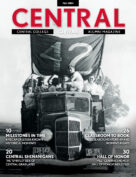
Angie Leonard Morrow ’94 likes objects with a history. But we’re not talking about your average flea-market finds. Morrow is responsible for cataloging and tracking items such as 2,000-pound Spirit Stones from China and Peruvian mummies at The Field Museum in Chicago.
Early in her college career, Morrow knew she wanted to work with historical objects. “One of the first classes I took at Central was cultural anthropology with Cynthia Mahmood,” she says. The class strengthened her interest in museums, as did a subsequent course on archaeology. A general studies major allowed Morrow the freedom to tailor her coursework to her intended career path, and she and adviser Michael Schrier worked to select courses in art history, U.S. history and world history, as well as a minor in geography.
Morrow has worked for a number of museums, both during college and after. She’s currently head registrar at The Field Museum, working with the anthropology collections. But what does a head registrar do?
“My side of the museum is the logistical, practical side,” she says. “My position is an administrative role in addition to handling the day-to-day tasks of registration and collections care. For example, registrars oversee collection storage, work with conservation, facilities and security as well as outside vendors for insurance and shipping, and our counterparts around the world to protect the works for future generations.”
Morrow’s job involves maintaining meticulous records of objects in the collections. These records document an object’s history or provenance, which is equally as important as the piece itself. “The object is of course very important, but without the history of the object you don’t know where it came from; you don’t know its significance to a culture,” she says.
The museum has only about a half a percent of its collection on view at any time, Morrow says, but one of the perks of her job is having access to the full collection of 25 million works. “I get to work with the objects hands-on that most people won’t ever see,” she says.
Head registrar—and most museum jobs—aren’t necessarily on college students’ radars. But Morrow says museums have a place for many types of careers. For instance, museums employ lawyers, historians, illustrators, educators and engineers.
During her time at Central, Morrow studied on programs in Chicago and Washington, D.C., which she says helped immensely in gaining experience in her field. In Chicago, she interned at The Field Museum, and in D.C., she worked with collections at the U.S. Treasury Department. In addition to getting hands-on experience, Morrow made contacts during the programs who have become long-term colleagues and mentors. Morrow says. “I still keep in touch with them and have used them as references over the years.”
Morrow says it’s helpful to gain as much experience as possible before graduation. She says, “I think it’s important to try as many things as you can, figure out what you’re good at, and what you want to pursue.”












To encourage serious, intellectual discourse on Civitas, please include your first and last name when commenting. Anonymous comments will be removed.
Comments are closed.